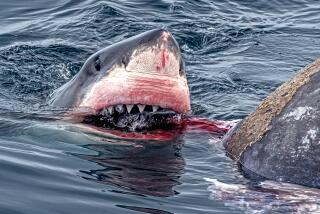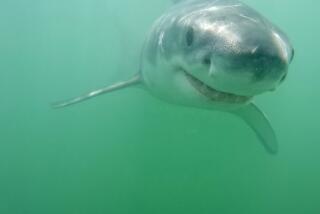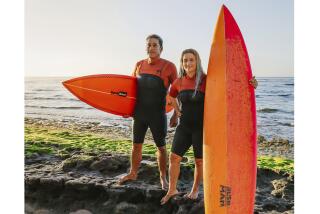‘Summer of the Shark,’ or Is It?
- Share via
OFF FLORIDA'S ATLANTIC COAST — Twenty feet down, in these sun-warmed, green waters, they’re here--some of the most-feared creatures on Earth. And they’re hungry.
Drew Hatchett and Scott Malcom, lanky 17-year-old scuba divers from Iowa City, Iowa, paid $40 apiece to swim with the sharks. They and the other divers waited in a semicircle on the sandy, coral-dotted bottom, bubbles from their air tanks rising like showers of giant pearls.
Around the humans, seven nurse sharks--some 5 feet long--massed. The animals glided effortlessly through the water with mere flicks of the tail. A PVC pipe stuffed with fresh-cut bonito lured them there.
This, one of Florida’s leading newspapers has decreed, is the “summer of the shark”--in large part because of two horrific incidents that captured public attention in an otherwise slow news month:
In July, an 8-year-old boy had his arm torn off by a bull shark off the Panhandle coast. Surgeons were able to reattach the limb. Then earlier this month, a Wall Street banker was bitten as he swam in the Bahamas, and his badly mauled leg had to be amputated.
Some experts on shark behavior think that the odds for such attacks have been increased recklessly by so-called shark-feeding excursions. Growing in popularity both here and abroad, the tourist outings bring greater numbers of sharks and humans face to face.
Back in Iowa, worried family members and friends warned Hatchett and Malcom not to tempt fate. But they joined the dive anyway, signing a release beforehand to absolve the operator of blame if something were to go wrong.
As the teens remained motionless on the seabed, one of the nurse sharks struck Hatchett on the forehead with a twitch of its tail as it passed. “You felt it, and you had to move,” he said, adding that he was never afraid.
At times, the sharks approached the divers head on, eyeball to eyeball, then veered away. “It’s a pretty cool feeling,” Malcom said later. “You know they are a lot more powerful than you.”
For weeks, the sea’s most terrifying creature to man has been among Florida’s top newsmakers.
In addition to the earlier brutal attacks, a shark last weekend nipped an 18-year-old on the upper left thigh and right foot off New Smyrna Beach, a mecca for surfers. He was the ninth person to be bitten off that same beach in a week.
On Monday, officials kept a one-mile stretch of that Atlantic Ocean shoreline closed after 20 sharks were spotted swimming nearby. Still, William Goettel, 69, received a minor bite to the left heel and was treated at the beach Monday, officials said. He was bitten in three feet of water about five miles south of the closure zone.
Earlier this month, a school of hundreds of sharks was sighted in Florida’s Gulf Coast waters. But they soon vanished, with experts conjecturing that they had headed south to warmer waters.
But is it really the summer of the shark? George Burgess, an ichthyologist and director of the International Shark Attack File, says no.
“This year, we predict, will be pretty much an average sort of year,” Burgess said in a telephone interview from his office at the Florida Museum of Natural History in Gainesville.
“In the U.S. last year, there were 51 attacks; this year [there have been] 29,” he said. “So we’ll probably fall short of those numbers.”
Worldwide, 41 attacks have been recorded so far in 2001, versus 79 in 2000. Twenty of this year’s bitings have been off New Smyrna Beach, where inlets rich in mullet, pilchard and other baitfish entice the sharks close to shore--and where surfers abound.
According to Burgess, there is no mystery about the high rate of attacks at New Smyrna Beach, probably by blacktip and spinner sharks whose bite is often little more serious than that of a dog.
The predators, pursuing fish, are blinded in the churning surf and bite whatever they encounter. If it’s not a fish, they quickly let go. “These are cases of mistaken identity, where the shark thinks it has a mullet or something,” Burgess said.
“From a scientific perspective, the real story is not shark bites man, but man bites shark. In any given year, humans are killing about 100 million sharks and their relatives, skates and rays. In the same year, the average is eight humans killed.”
That’s better than a 10 million-to-1 kill ratio in favor of humans, the ichthyologist pointed out.
But that likely will change, Burgess said. The U.S. and world populations are growing, and more and more people swim these days, he said. Plus the economy is fairly good, and an increasing number of people take beach vacations.
“We’re seeing more and more human hours in the water each year,” he said. “What we can predict pretty reasonably is that we should have more and more attacks each year.”
For 3 1/2 years, skipper Jeff Torode has taken divers and snorkelers to a reef off Pompano Beach, Fla., that he calls “the nursery,” where two families of nurse sharks live. It is a species with raspy teeth that sucks up its food from the sea bottom and that, in spite of its fearsome appearance, prefers crabs and mollusks to human flesh.
“We’re not on their menu,” the 43-year-old Torode assures anyone who’s skittish aboard his 40-passenger Aqua View.
Torode says 15,000 passengers have been to the reef and back with him, without a single injury. On only one dive was a more dangerous type of shark--a hammerhead--seen, and it quickly swam away.
“You see the sharks we deal with,” he said. “We trust them. They trust us.”
However, a rising chorus of critics opposes such excursions as needlessly dangerous. Last week, Florida state Rep. Charles Justice, a Democrat from St. Petersburg, announced he was proposing legislation to ban the dives because, he said, they teach sharks to associate the presence of humans with eating.
“The sound of boat engines means food for sharks now,” Justice told Reuters.
Next month, the Florida Fish and Wildlife Conservation Commission is scheduled to consider adopting guidelines for its own for shark-feeding operations.
Despite Torode’s unblemished record, according to statistics kept by the International Shark Attack File, there have been about two dozen reported injuries to participants in shark-feeding dives worldwide. None has been serious, Burgess said. But, he added, “shark attack is an odds game.”
“If you get enough sharks in the water, and enough people in the water, you’re going to have an attack,” he said. “Sooner or later, somebody is going to have a real nasty injury, lose a hand or a foot.”
Torode thinks this is “Chicken Little” reasoning. “Maybe I don’t have a PhD, but I guarantee you I know how the shark is going to behave, what he’s going to do,” said the man with two decades of diving experience.
Leaders of the diving industry estimate that 100,000 people a year take part in shark-feeding dives at about 300 sites in 40 countries. And they have defended the trips as unique opportunities to learn about sharks.
For about an hour on this warm Florida day, the divers remained on the ocean floor off Pompano Beach, marveling at the sharks’ grace and might. When the creatures approached, some divers reached out and touched them.
From the ocean’s surface, snorkelers looked down on the scene. A Chicago couple brought their 5-year-old son, who paddled happily. Back on shore, somebody asked the boy what he saw. “Some nice sharks,” he said.
Torode scoffed at the notion that there is anything different about sharks this summer. “Everybody is making like this is a cancer, but it isn’t. It’s the media that’s doing the real feeding frenzy.”
More to Read
Sign up for Essential California
The most important California stories and recommendations in your inbox every morning.
You may occasionally receive promotional content from the Los Angeles Times.










